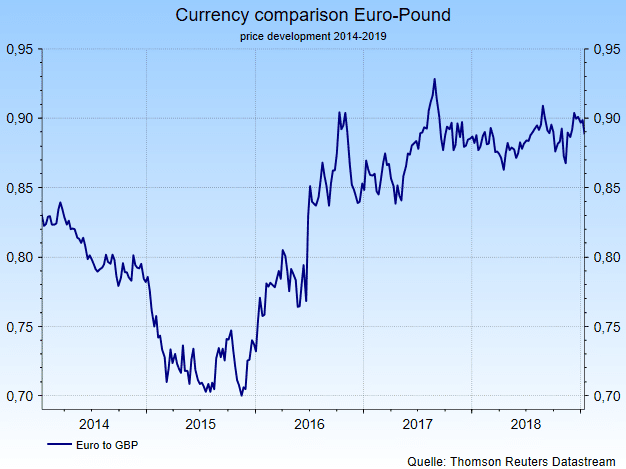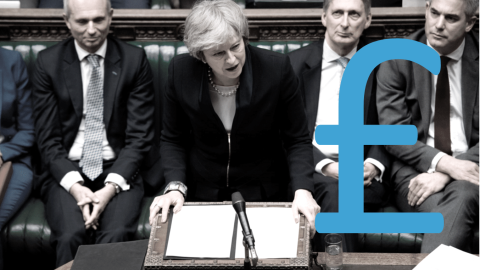The British House of Commons rejected the Brexit treaty. Theresa May wasted two and a half years since the Brexit referendum took place to find an acceptable treaty and consensus in Parliament. This result was generally expected. There is little time for further negotiations. The chaotic conditions are prolonged.
There are basically four possible scenarios how things will further develop:

The euro gained immensely in regards to the British Pound in the past 5 years.
1) A “hard” BREXIT
Or a withdrawal of the United Kingdom without a withdrawal agreement. Prime Minister May now has time until Monday (should she politically survive the vote of no confidence against her tonight) for an alternative plan to submit to House of Commons. This is not a realistic scenario. Resolutions for a change in the withdrawal agreement are likely to be passed. However, it will be difficult to find a consensus in Parliament. Even if a majority is found in Parliament for a position, it still has to be negotiated with the EU. There is not much time left. It is likely here that British MEPs accept the “hard” Brexit. This environment is very negative for the British pound.
2) Request for an extension for the deadline (29 March).
That is possible, but the other 27 EU countries would have to agree. The extended deadline would likely be ahead of the EU general elections starting May 23. Much is possible in this scenario: a new referendum on EU membership or new elections could take place. This could result in two ways: either no Brexit (see number 4) or again tough negotiations with an unpredictable outcome between the British government and the House of Commons as well as the EU. The outlook for the British environment remains very uncertain. Of course, a compromise could be found between the UK and Parliament.
3) “Orderly” Brexit leaving the UK with a withdrawal agreement.
The existing withdrawal contract is accepted. The negotiations on the best trade relations between the United Kingdom and the EU can begin. For example, the UK could either stay in the Customs Union or join the European Free Trade Association (EFTA). That would make a “soft” Brexit. Or the transition period after Brexit could be extended for a long period. This scenario is favorable for the British pound.
4) No Brexit or withdrawal from the exit process according to Article 50.
Whether there will be a majority in parliament for this scenario before a new referendum or before new elections is questionable. However, the parliament could pass a law stating that the UK should stay in the EU unless a compromise is found between the EU and the UK. The legal “default” is changed from “hard Brexit to” no Brexit “. This scenario is very positive for the British pound.
The list of misperceptions is getting longer (David Cameron on the outcome of the Brexit referendum, Theresa May with the threat of a “hard” Brexit). Thus, all that remains is the hope that the rational arguments outweigh and the British at least avoid leaving without a contract.
Legal note:
Prognoses are no reliable indicator for future performance.
Legal disclaimer
This document is an advertisement. Unless indicated otherwise, source: Erste Asset Management GmbH. The language of communication of the sales offices is German and the languages of communication of the Management Company also include English.
The prospectus for UCITS funds (including any amendments) is prepared and published in accordance with the provisions of the InvFG 2011 as amended. Information for Investors pursuant to § 21 AIFMG is prepared for the alternative investment funds (AIF) administered by Erste Asset Management GmbH pursuant to the provisions of the AIFMG in conjunction with the InvFG 2011.
The currently valid versions of the prospectus, the Information for Investors pursuant to § 21 AIFMG, and the key information document can be found on the website www.erste-am.com under “Mandatory publications” and can be obtained free of charge by interested investors at the offices of the Management Company and at the offices of the depositary bank. The exact date of the most recent publication of the prospectus, the languages in which the fund prospectus or the Information for Investors pursuant to Art 21 AIFMG and the key information document are available, and any other locations where the documents can be obtained are indicated on the website www.erste-am.com. A summary of the investor rights is available in German and English on the website www.erste-am.com/investor-rights and can also be obtained from the Management Company.
The Management Company can decide to suspend the provisions it has taken for the sale of unit certificates in other countries in accordance with the regulatory requirements.
Note: You are about to purchase a product that may be difficult to understand. We recommend that you read the indicated fund documents before making an investment decision. In addition to the locations listed above, you can obtain these documents free of charge at the offices of the referring Sparkassen bank and the offices of Erste Bank der oesterreichischen Sparkassen AG. You can also access these documents electronically at www.erste-am.com.
Our analyses and conclusions are general in nature and do not take into account the individual characteristics of our investors in terms of earnings, taxation, experience and knowledge, investment objective, financial position, capacity for loss, and risk tolerance. Past performance is not a reliable indicator of the future performance of a fund.
Please note: Investments in securities entail risks in addition to the opportunities presented here. The value of units and their earnings can rise and fall. Changes in exchange rates can also have a positive or negative effect on the value of an investment. For this reason, you may receive less than your originally invested amount when you redeem your units. Persons who are interested in purchasing units in investment funds are advised to read the current fund prospectus(es) and the Information for Investors pursuant to § 21 AIFMG, especially the risk notices they contain, before making an investment decision. If the fund currency is different than the investor’s home currency, changes in the relevant exchange rate can positively or negatively influence the value of the investment and the amount of the costs associated with the fund in the home currency.
We are not permitted to directly or indirectly offer, sell, transfer, or deliver this financial product to natural or legal persons whose place of residence or domicile is located in a country where this is legally prohibited. In this case, we may not provide any product information, either.
Please consult the corresponding information in the fund prospectus and the Information for Investors pursuant to § 21 AIFMG for restrictions on the sale of the fund to American or Russian citizens.
It is expressly noted that this communication does not provide any investment recommendations, but only expresses our current market assessment. Thus, this communication is not a substitute for investment advice.
This document does not represent a sales activity of the Management Company and therefore may not be construed as an offer for the purchase or sale of financial or investment instruments.
Erste Asset Management GmbH is affiliated with the Erste Bank and austrian Sparkassen banks.
Please also read the “Information about us and our securities services” published by your bank.
